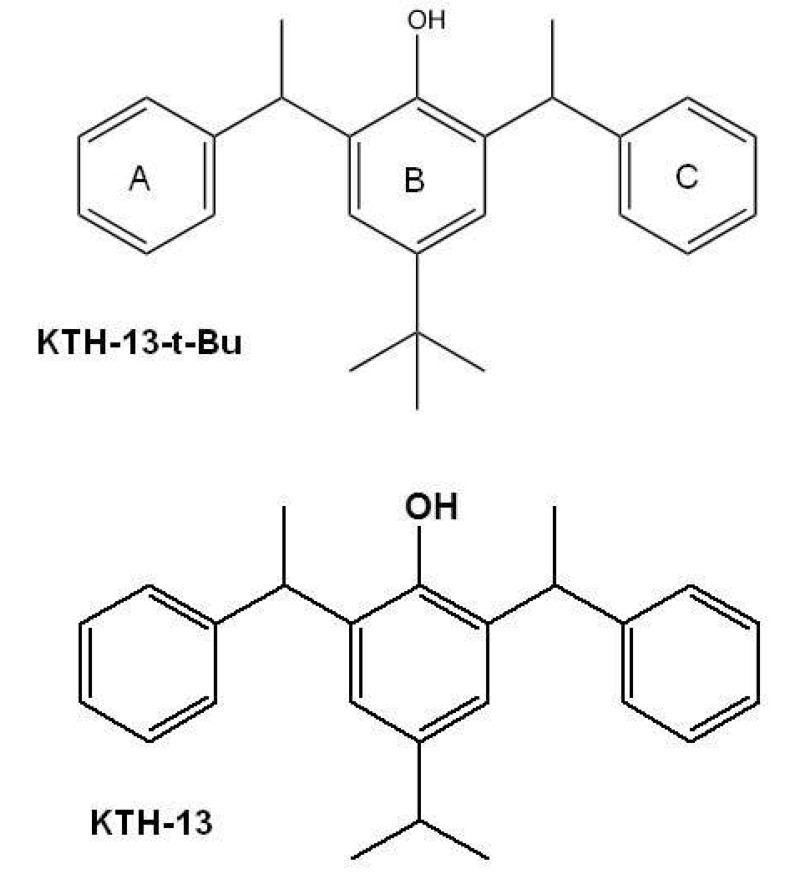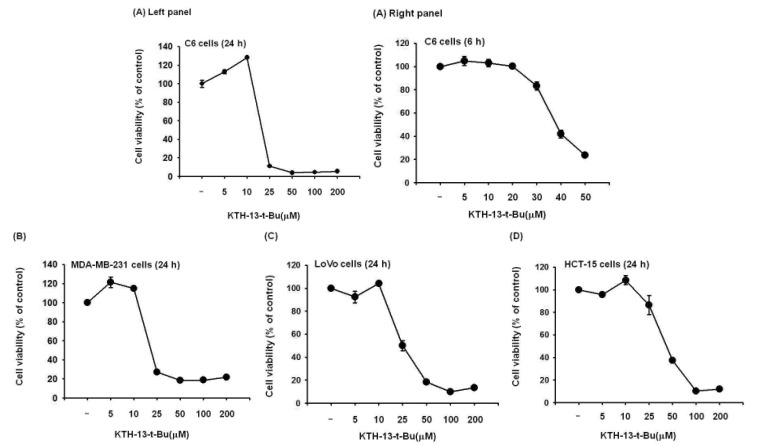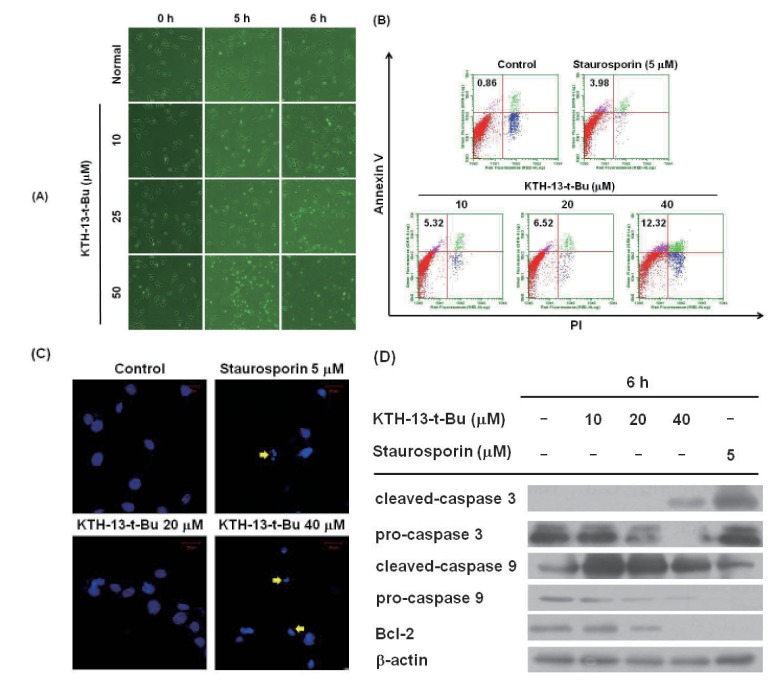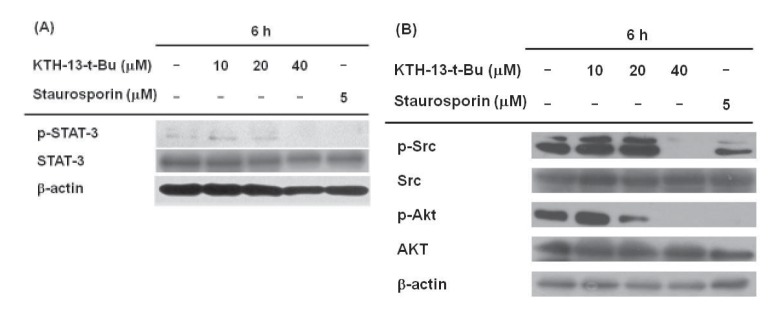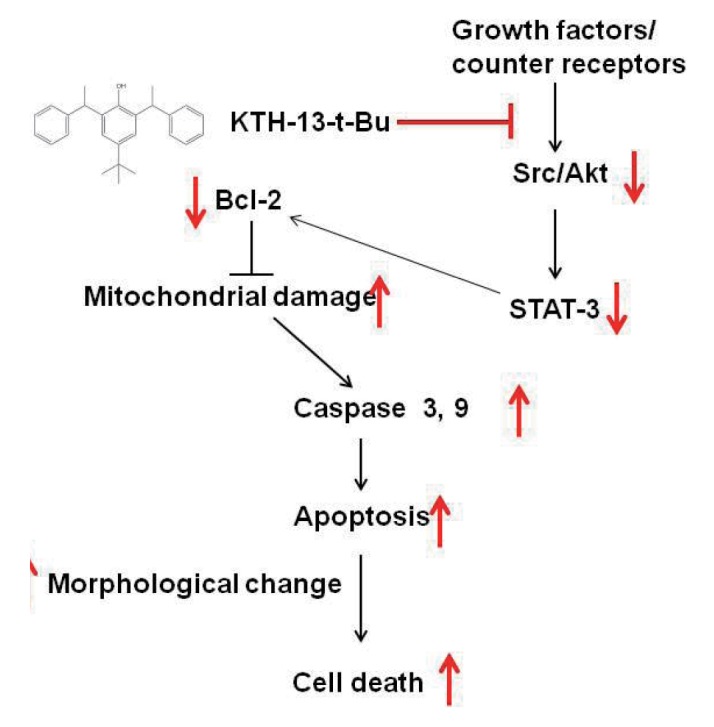Korean J Physiol Pharmacol.
2016 May;20(3):253-259. 10.4196/kjpp.2016.20.3.253.
4-(Tert-butyl)-2,6-bis(1-phenylethyl)phenol induces pro-apoptotic activity
- Affiliations
-
- 1Depatment of Genetic Engineering, Sungkyunkwan University, Suwon 16419, Korea. jaecho@skku.edu
- 2Department of Chemistry, Kwangwoon University, Seoul 01897, Korea.
- 3School of Systems Biomedical Science, Soongsil University, Seoul 06978, Korea. kimmy@ssu.ac.kr
- KMID: 2285597
- DOI: http://doi.org/10.4196/kjpp.2016.20.3.253
Abstract
- Previously, we found that KTH-13 isolated from the butanol fraction of Cordyceps bassiana (Cb-BF) displayed anti-cancer activity. To improve its antiproliferative activity and production yield, we employed a total synthetic approach and derivatized KTH-13 to obtain chemical analogs. In this study, one KTH-13 derivative, 4-(tert-butyl)-2,6-bis(1-phenylethyl)phenol (KTH-13-t-Bu), was selected to test its anti-cancer activity. KTH-13-t-Bu diminished the proliferation of C6 glioma, MDA-MB-231, LoVo, and HCT-15 cells. KTH-13-t-Bu induced morphological changes in C6 glioma cells in a dose-dependent manner. KTH-13-t-Bu also increased the level of early apoptotic cells stained with annexin V-FITC. Furthermore, KTH-13-t-Bu increased the levels of cleaved caspase-3 and -9. In contrast, KTH-13-t-Bu upregulated the levels of pro- and cleaved forms of caspase-3, -8, and -9 and Bcl-2. Phospho-STAT3, phospho-Src, and phospho-AKT levels were also diminished by KTH13-t-Bu treatment. Therefore, these results strongly suggest that KTH-13-t-Bu can be considered a novel anti-cancer drug displaying pro-apoptotic activity.
Keyword
Figure
Reference
-
1. Ng TB, Wang H. Pharmacological actions of cordyceps, a prized folk medicine. J Pharm Pharmacol. 2005; 57:1509–1519. PMID: 16354395.
Article2. Zhou X, Gong Z, Su Y, Lin J, Tang K. Cordyceps fungi: natural products, pharmacological functions and developmental products. J Pharm Pharmacol. 2009; 61:279–291. PMID: 19222900.
Article3. Holliday JC, Cleaver MP. Medicinal value of the caterpillar fungi species of the genus cordyceps (Fr.) link (Ascomycetes). A review. Int J Med Mushrooms. 2008; 10:219–234.
Article4. Jayakumar T, Chiu CC, Wang SH, Chou DS, Huang YK, Sheu JR. Anti-cancer effects of CME-1, a novel polysaccharide, purified from the mycelia of cordyceps sinensis against B16-F10 melanoma cells. J Cancer Res Ther. 2014; 10:43–49. PMID: 24762485.5. Byeon SE, Lee SY, Kim AR, Lee J, Sung GH, Jang HJ, Kim TW, Park HJ, Lee SJ, Hong S, Cho JY. Inhibition of cytokine expression by a butanol extract from cordyceps bassiana. Pharmazie. 2011; 66:58–62. PMID: 21391436.6. Wu G, Li L, Sung GH, Kim TW, Byeon SE, Cho JY, Park CW, Park HJ. Inhibition of 2, 4-dinitrofluorobenzene-induced atopic dermatitis by topical application of the butanol extract of cordyceps bassiana in NC/Nga mice. J Ethnopharmacol. 2011; 134:504–509. PMID: 21184821.7. Antiproliferative and apoptosis-inducing activities of 4-Isopropyl-2, 6-bis (1-phenylethyl) phenol isolated from butanol fraction of cordyceps bassiana. Evid Based Complement Alternat Med. 2015; DOI: 10.1155/2015/739874.8. Kim MY, Yoo BC, Cho JY. Ginsenoside-Rp1-induced apolipoprotein A-1 expression in the LoVo human colon cancer cell line. J Ginseng Res. 2014; 38:251–255. PMID: 25379004.
Article9. Twentyman PR, Luscombe M. A study of some variables in a tetrazolium dye (MTT) based assay for cell growth and chemosensitivity. Br J Cancer. 1987; 56:279–285. PMID: 3663476.
Article10. Kim MY, Cho JY. 20S-dihydroprotopanaxadiol, a ginsenoside derivative, boosts innate immune responses of monocytes and macrophages. J Ginseng Res. 2013; 37:293–299. PMID: 24198654.
Article11. Kim MY, Cho JY. 20S-dihydroprotopanaxatriol modulates functional activation of monocytes and macrophages. J Ginseng Res. 2013; 37:300–307. PMID: 24198655.
Article12. Kothakota S, Azuma T, Reinhard C, Klippel A, Tang J, Chu K, McGarry TJ, Kirschner MW, Koths K, Kwiatkowski DJ. Caspase-3-generated fragment of gelsolin: effector of morphological change in apoptosis. Science. 1997; 278:294–298. PMID: 9323209.
Article13. Satzger I, Mattern A, Kuettler U, Weinspach D, Voelker B, Kapp A, Gutzmer R. MicroRNA-15b represents an independent prognostic parameter and is correlated with tumor cell proliferation and apoptosis in malignant melanoma. Int J Caner. 2010; 126:2553–2562.
Article14. Chang Y, Yang ST, Liu JH, Dong E, Wang Y, Cao A, Liu Y, Wang H. In vitro toxicity evaluation of graphene oxide on A549 cells. Toxicol Lett. 2011; 200:201–210. PMID: 21130147.
Article15. Lee HS, Jung KK, Cho JY, Rhee MH, Hong S, Kwon M, Kim SH, Kang SY. Neuroprotective effect of curcumin is mainly mediated by blockade of microglial cell activation. Pharmazie. 2007; 62:937–942. PMID: 18214347.16. Jang YJ, Won JH, Back MJ, Fu Z, Jang JM, Ha HC, Hong S, Chang M, Kim DK. Paraquat induces apoptosis through a mitochondria-dependent pathway in RAW264.7 cells. Biomol Ther (Seoul). 2015; 23:407–413. PMID: 26336579.
Article17. Kim JH, Lee YG, Yoo S, Oh J, Jeong D, Song WK, Yoo BC, Rhee MH, Park J, Cha SH, Hong S, Cho JY. Involvement of Src and the actin cytoskeleton in the antitumorigenic action of adenosine dialdehyde. Biochem Pharmacol. 2013; 85:1042–1056. PMID: 23353701.
Article18. Kim JH, Lee Y, Sung GH, Kim HG, Jeong D, Park JG, Baek KS, Sung NY, Yang S, Yoon DH, Lee SY, Kang H, Song C, Cho JH, Lee KH, Kim TW, Cho JY. Antiproliferative and apoptosis-inducing activities of 4-Isopropyl-2,6-bis(1-phenylethyl)phenol isolated from butanol fraction of cordyceps bassiana. Evid Based Complement Alternat Med. 2015; DOI: 10.1155/2015/739874.19. Orrenius S. Reactive oxygen species in mitochondria-mediated cell death. Drug Metab Rev. 2007; 39:443–455. PMID: 17786631.
Article20. Igney FH, Krammer PH. Death and anti-death: tumour resistance to apoptosis. Nat Rev Cancer. 2002; 2:277–288. PMID: 12001989.
Article21. Tian T, Song L, Zheng Q, Hu X, Yu R. Induction of apoptosis by cordyceps militaris fraction in human chronic myeloid leukemia K562 cells involved with mitochondrial dysfunction. Pharmacogn Mag. 2014; 10:325–331. PMID: 25210321.
Article22. Ji J, Liu J, Liu H, Wang Y. Effects of fermented mushroom of cordyceps sinensis, Rich in selenium, on uterine cervix cancer. Evid Based Complement Alternat Med. 2014; DOI: 10.1155/2014/173180.23. Shinohara K, Tomioka M, Nakano H, Tone S, Ito H, Kawashima S. Apoptosis induction resulting from proteasome inhibition. Biochem J. 1996; 317:385–388. PMID: 8713062.
Article24. Jin CY, Kim GY, Choi YH. Induction of apoptosis by aqueous extract of cordyceps militaris through activation of caspases and inactivation of Akt in human breast cancer MDA-MB-231 cells. J Microbiol Biotechnol. 2008; 18:1997–2003. PMID: 19131705.25. Park EH, Kim YJ, Yamabe N, Park SH, Kim HK, Jang HJ, Kim JH, Cheon GJ, Ham J, Kang KS. Stereospecific anticancer effects of ginsenoside Rg3 epimers isolated from heat-processed American ginseng on human gastric cancer cell. J Ginseng Res. 2014; 38:22–27. PMID: 24558306.
Article26. Chen Y, Yang SH, Hueng DY, Syu JP, Liao CC, Wu YC. Cordycepin induces apoptosis of C6 glioma cells through the adenosine 2A receptor-p53-caspase-7-PARP pathway. Chem Biol Interact. 2014; 216:17–25. PMID: 24704558.
Article27. Foerster F, Braig S, Moser C, Kubisch R, Busse J, Wagner E, Schmoeckel E, Mayr D, Schmitt S, Huettel S, Zischka H, Mueller R, Vollmar AM. Targeting the actin cytoskeleton: selective antitumor action via trapping PKCε. Cell Death Dis. 2014; 5:e1398. PMID: 25165884.
Article28. Vermes I, Haanen C, Steffens-Nakken H, Reutellingsperger C. A novel assay for apoptosis flow cytometric detection of phosphatidylserine expression on early apoptotic cells using fluorescein labelled annexin V. J immunol methods. 1995; 184:39–51. PMID: 7622868.
Article29. Zhang G, Gurtu V, Kain SR, Yan G. Early detection of apoptosis using a fluorescent conjugate of annexin V. Biotechniques. 1997; 23:525–531. PMID: 9298227.
Article30. Wi SM, Lee KY. 5-aminoimidazole-4-carboxamide Riboside induces apoptosis through AMP-activated protein kinase-independent and NADPH oxidase-dependent pathways. Immune Netw. 2014; 14:241–248. PMID: 25360075.
Article31. Kim YC, Song SB, Lee SK, Park SM, Kim YS. The nuclear orphan receptor NR4A1 is involved in the apoptotic pathway induced by LPS and Simvastatin in RAW 264.7 macrophages. Immune Netw. 2014; 14:116–122. PMID: 24851101.
Article32. Johnson V, Ko S, Holmstrom T, Eriksson J, Chow S. Effector caspases are dispensable for the early nuclear morphological changes during chemical-induced apoptosis. J Cell Sci. 2000; 113:2941–2953. PMID: 10934034.
Article33. Nuñez G, Benedict MA, Hu Y, Inohara N. Caspases: the proteases of the apoptotic pathway. Oncogene. 1998; 17:3237–3245. PMID: 9916986.
Article34. Kim B, Srivastava SK, Kim SH. Caspase-9 as a therapeutic target for treating cancer. Expert Opin Ther Targets. 2015; 19:113–127. PMID: 25256701.
Article35. Oltval ZN, Milliman CL, Korsmeyer SJ. Bcl-2 heterodimerizes in vivo with a conserved homolog, bax, that accelerates programed cell death. Cell. 1993; 74:609–619. PMID: 8358790.
Article36. Clark AR, Toker A. Signalling specificity in the Akt pathway in breast cancer. Biochem Soc Trans. 2014; 42:1349–1355. PMID: 25233414.
Article37. Zhang X, Shan P, Alam J, Fu XY, Lee PJ. Carbon monoxide differentially modulates STAT1 and STAT3 and inhibits apoptosis via a phosphatidylinositol 3-kinase/Akt and p38 kinase-dependent STAT3 pathway during anoxia-reoxygenation injury. J Biol Chem. 2005; 280:8714–8721. PMID: 15590660.
Article38. Li H, Marshall AJ. Phosphatidylinositol (3,4) bisphosphate-specific phosphatases and effector proteins: a distinct branch of PI3K signaling. Cell Signal. 2015; 27:1789–1798. PMID: 26022180.
Article39. Rho O, Kim DJ, Kiguchi K, Digiovanni J. Growth factor signaling pathways as targets for prevention of epithelial carcinogenesis. Mol Carcinog. 2011; 50:264–279. PMID: 20648549.
Article40. Kundu J, Choi BY, Jeong CH, Kundu JK, Chun KS. Thymoquinone induces apoptosis in human colon cancer HCT116 cells through inactivation of STAT3 by blocking JAK2-and Src mediated phosphorylation of EGF receptor tyrosine kinase. Oncol Rep. 2014; 32:821–828. PMID: 24890449.
- Full Text Links
- Actions
-
Cited
- CITED
-
- Close
- Share
- Similar articles
-
- Anti-Proliferative and Pro-Apoptotic Activities of 4-Methyl-2,6-bis(1-phenylethyl)phenol in Cancer Cells
- Role of Ca2+ influx in the tert-butyl hydroperoxide-induced apoptosis of HepG2 human hepatoblastoma cellse
- Inhibitory effects of 2,6-di-tert-butyl-4-hydroxymethylphenol on asthmatic responses to ovalbumin challenge in conscious guinea pigs
- Resveratrol at High Doses Acts as an Apoptotic Inducer in Endothelial Cells
- Mechanisms of TERT Reactivation and Its Interaction with BRAFV600E

